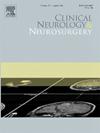Neurological deficit due to vasospasm after brain tumour resection: A single centre retrospective cohort
IF 1.8
4区 医学
Q3 CLINICAL NEUROLOGY
引用次数: 0
Abstract
Background and objectives
Neurological deficit secondary to cerebral vasospasm following tumour resection is a rare yet significant complication that can lead to considerable morbidity and mortality. Pathophysiological mechanisms underlying postoperative vasospasm are complex and multifactorial It is an underdiagnosed entity, with severe consequences. The main objective of this study is to describe the characteristics of patients with vasospasm after tumour resection in a referral centre.
Methods
We performed a retrospective cohort study of consecutive patients who presented post-surgical vasospasm between January 2017 and May 2024 at single institution. The demographic data, tumour features, surgical characteristics, vasospasm diagnosis and management were collected.
Results
twenty-two patients were enrolled, median age was 41 years, and 41 % were female. The location most frequent of lesions was in the sellar/suprasellar space (73 %), and pituitary tumours were the most common pathology. The average time to develop vasospasm was 3 days and mostly was diagnosed using transcranial Doppler (86 %). Almost all patients had the anterior circulation affected (91 %). All patients had pharmacological and supportive treatment, and more than half needed nimodipine. Incomplete recovery after vasospasm was reported in 13 patients (59 %), and 3 patients (14 %) died. No association was seen between outcome and the probable causative factors.
Conclusions
Cerebral vasospasm due to tumour resection is a rare but challenging complication with remarkably high morbidity and mortality in reported cases. A high index of suspicion is required for early diagnosis and prompt management. It should be considered in post-surgical patients with neurological impairment without obvious cause.
求助全文
约1分钟内获得全文
求助全文
来源期刊

Clinical Neurology and Neurosurgery
医学-临床神经学
CiteScore
3.70
自引率
5.30%
发文量
358
审稿时长
46 days
期刊介绍:
Clinical Neurology and Neurosurgery is devoted to publishing papers and reports on the clinical aspects of neurology and neurosurgery. It is an international forum for papers of high scientific standard that are of interest to Neurologists and Neurosurgeons world-wide.
 求助内容:
求助内容: 应助结果提醒方式:
应助结果提醒方式:


